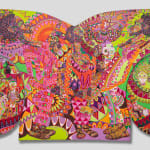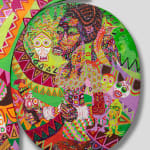 Wadsworth Jarrell, Prophecy
Wadsworth Jarrell, Prophecy
 Wadsworth Jarrell, Prophecy (detail)
Wadsworth Jarrell, Prophecy (detail)
 Wadsworth Jarrell, Prophecy (detail)
Wadsworth Jarrell, Prophecy (detail)
 Wadsworth Jarrell, Prophecy (detail)
Wadsworth Jarrell, Prophecy (detail)
 Installation View, AFRICOBRA: Nation Time, La Biennale di Venezia, 2019
Installation View, AFRICOBRA: Nation Time, La Biennale di Venezia, 2019
Wadsworth Jarrell
Prophecy, 1974
acrylic on canvas
48 x 85 1/2 in (121.9 x 217.2 cm)
Copyright The Artist
Further images
In 1974, Wadsworth Jarrell created 'Prophecy' as a tribute to South Africa's struggle with apartheid, aiming to promote unity among the black community and reconnect them to their African heritage....
In 1974, Wadsworth Jarrell created "Prophecy" as a tribute to South Africa's struggle with apartheid, aiming to promote unity among the black community and reconnect them to their African heritage. This piece was notably featured in the Second World Black and African Festival of Arts and Culture (FESTAC '77) in Lagos, Nigeria. AfriCOBRA's participation in FESTAC '77, which brought together diasporic artists and thinkers from the performing, visual, and literary arts, significantly contributed to the trans-African legacy of the movement. "Prophecy," painted in vibrant AfriCOBRA colors, depicts five black female figures with elongated proportions, inspired by a colleague from Howard University. The central panel features three figures, two holding guns symbolizing resistance to apartheid, and roosters representing South Africa's struggle for liberation. The piece also includes references to Botswana and the phrases "At Any Price" and "JUJU," with the letter B for "Black is Beautiful" recurring throughout. The figures hold sculptures of the Yoruba deity Shango, symbolizing power and resistance. Shango, a powerful Orisha from Yoruba mythology, represents lightning, thunder, and justice.
Wadsworth Jarrell (b. 1929, Albany, GA) is a painter, photographer and founding member of AfriCOBRA, a Chicago-based collective of black artists who developed their own visual aesthetic in the art world to empower black communities. Wadsworth’s pattern-intensive portraits, combining vibrant colors and Black Power slogans, depict his drive for political activism. He documented the musical life that flourished in Chicago in the late 1960s-1970s and was a member of the Organization of Black American Culture that painted the “Rhythm and Blues” section of The Wall of Respect mural in the South Side of Chicago. Currently, he continues to experiment in his practice with past and present topics surrounding Blackness.
During his tenure as a professor at Howard University, Jarrell's studies in African art and culture influenced him to incorporate Senufo sculpture symbolism into his art. Robert L. Douglas notes that Jarrell shifted from naturalistic human proportions to the African sculptural style of three to four heads high, typical of the Senufo culture, known for its abstract and geometric forms. Jarrell, a founding member of AfriCOBRA, helped develop a visual aesthetic to empower black communities, marked by vibrant colors, bold text, and positive imagery. His work celebrated black culture and political activism, documenting the vibrant musical scene in Chicago during the late 1960s and 1970s. Jarrell's art is part of numerous prestigious collections and exhibitions, and he continues to explore themes of Blackness in his practice.
Wadsworth Jarrell (b. 1929, Albany, GA) is a painter, photographer and founding member of AfriCOBRA, a Chicago-based collective of black artists who developed their own visual aesthetic in the art world to empower black communities. Wadsworth’s pattern-intensive portraits, combining vibrant colors and Black Power slogans, depict his drive for political activism. He documented the musical life that flourished in Chicago in the late 1960s-1970s and was a member of the Organization of Black American Culture that painted the “Rhythm and Blues” section of The Wall of Respect mural in the South Side of Chicago. Currently, he continues to experiment in his practice with past and present topics surrounding Blackness.
During his tenure as a professor at Howard University, Jarrell's studies in African art and culture influenced him to incorporate Senufo sculpture symbolism into his art. Robert L. Douglas notes that Jarrell shifted from naturalistic human proportions to the African sculptural style of three to four heads high, typical of the Senufo culture, known for its abstract and geometric forms. Jarrell, a founding member of AfriCOBRA, helped develop a visual aesthetic to empower black communities, marked by vibrant colors, bold text, and positive imagery. His work celebrated black culture and political activism, documenting the vibrant musical scene in Chicago during the late 1960s and 1970s. Jarrell's art is part of numerous prestigious collections and exhibitions, and he continues to explore themes of Blackness in his practice.
Provenance
Collection of Wadsworth JarrellExhibitions
La Biennale di Venezia, AFRICOBRA: Nation Time, Venice, Italy, 2019.Kavi Gupta, Africobra50, Chicago, IL, 2019.
Museum of Contemporary Art North Miami, AFRICOBRA: Messages to the People, 2018.
Atlanta, Georgia, Solo Exhibition, Wadsworth Jarrell, Brawley Library, 1988.
First Black Arts Festival, Lagos, Nigeria, 1998.
Banks-Haley Gallery, Albany, GA, Solo Exhibition, Wadsworth Jarrell, 1979.
FESTAC ‘77, Lagos, Nigeria, 1977.
Literature
J.M. Hayes, AfriCobra; Messages to the People, New York, 2020, illustrated pp, 114 - 115.Robert L Douglas, Wadsworth Jarrell: The Artist as Revolutionary, Pomegranate, 1996, illustrated pp. 46.
Join our mailing list
* denotes required fields
We will process the personal data you have supplied in accordance with our privacy policy (available on request). You can unsubscribe or change your preferences at any time by clicking the link in our emails.





